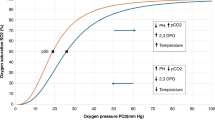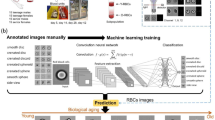Abstract
Background:
Anemia, a common condition among critically ill premature infants, is affected by red blood cell (RBC) survival (RCS). We hypothesized that transfused allogeneic Kidd antigen–mismatched RBCs would demonstrate the same concurrent RCS tracking as RBCs multilabeled at separate, discrete low densities with biotin (BioRBCs).
Methods:
Allogeneic RBCs from adult donors were labeled at four biotin densities, mixed, and transfused into 17 anemic premature infants. Nine of the donors and neonates were Kidd antigen mismatched. Serial posttransfusion blood samples were assayed for up to 8 wk by flow cytometry to track the survival of the proportions of Kidd antigen–mismatched and Kidd antigen–biotinylated RBCs.
Results:
Using linear mixed modeling to compare results, RCS of the three lowest BioRBC densities was similar to RCS by Kidd antigen mismatch and to one another. RCS of RBCs labeled at the highest BioRBC density was shortened.
Conclusion:
RCS of different populations of RBCs can be tracked concurrently and reliably using the three lowest BioRBC densities. Although comparable RCS results can be achieved using Kidd antigen mismatches, BioRBCs are preferred for investigating neonatal anemia because biotin labeling of both allogeneic and autologous RBCs is possible.
Similar content being viewed by others
Log in or create a free account to read this content
Gain free access to this article, as well as selected content from this journal and more on nature.com
or
References
Franco RS . The measurement and importance of red cell survival. Am J Hematol 2009;84:109–14.
Dancis J, Danoff S, Zabriskie J, Balis ME . Hemoglobin metabolism in the premature infant. J Pediatr 1959;54:748–55.
Garby L, Sjoelin S, Vuille JC . Studies on erythro-kinetics in infancy. v. estimations of the life span of red cells in the newborn. Acta Paediatr 1964;53:165–71.
Wynn R, Dixon S, al-Ismail SA, et al. Flow cytometric determination of pre-transfusion red cell volume in fetuses and neonates requiring transfusion based on RhD+ dilution by transfused D- red cells. Br J Haematol 1995;89:620–2.
Hudson I, Cooke A, Holland B, et al. Red cell volume and cardiac output in anaemic preterm infants. Arch Dis Child 1990;65(7 Spec No):672–5.
Phillips HM, Holland BM, Abdel-Moiz A, et al. Determination of red-cell mass in assessment and management of anaemia in babies needing blood transfusion. Lancet 1986;1:882–4.
Klein HG, Anstee DJ . Appendix 7. Red cell survival methods based on antigenic differences between donor and recipient. In: Mollison’s Blood Transfusion in Clinical Medicine. Oxford, UK: Blackwell Publishing, 2005:850–851.
Diekema DS . Conducting ethical research in pediatrics: a brief historical overview and review of pediatric regulations. J Pediatr 2006;149:Suppl 1:S3–11.
Mock DM, Matthews NI, Zhu S, et al. Red blood cell (RBC) survival determined in humans using RBCs labeled at multiple biotin densities. Transfusion 2011;51:1047–57.
Arbuckle TE, Wilkins R, Sherman GJ . Birth weight percentiles by gestational age in Canada. Obstet Gynecol 1993;81:39–48.
Mock DM, Matthews NI, Zhu S, et al. Red blood cell (RBC) volume can be independently determined in vivo in humans using RBCs labeled at different densities of biotin. Transfusion 2011;51:148–57.
Strauss RG, Mock DM, Widness JA, Johnson K, Cress G, Schmidt RL . Posttransfusion 24-hour recovery and subsequent survival of allogeneic red blood cells in the bloodstream of newborn infants. Transfusion 2004;44:871–6.
Brugnara C, Platt OS . The neonatal erythrocyte and its disorders. In: Nathan DG, Oski FA, eds. Nathan and Oski’s Hematology of Infancy and Childhood. Philadelphia, PA: WB Saunders, 2003:19–55.
Dumont LJ, AuBuchon JP . Evaluation of proposed FDA criteria for the evaluation of radiolabeled red cell recovery trials. Transfusion 2008;48:1053–60.
Dumont LJ, AuBuchon JP . BEST Collaborative. Evaluation of proposed FDA criteria for evaluation of radiolabeled red cell recovery trials, 2008. (http://www.fda.gov/ohrms/dockets/ac/08/slides/2008-4355S1-00-index.html).
Silver HM, Seebeck M, Carlson R . Comparison of total blood volume in normal, preeclamptic, and nonproteinuric gestational hypertensive pregnancy by simultaneous measurement of red blood cell and plasma volumes. Am J Obstet Gynecol 1998;179:87–93.
Recommended method for radioisotope red-cell survival studies. International Committee for Standardization in Haematology. Br J Haematol 1980;45:659–66.
Mock DM, Lankford GL, Widness JA, Burmeister LF, Kahn D, Strauss RG . Measurement of red cell survival using biotin-labeled red cells: validation against 51Cr-labeled red cells. Transfusion 1999;39:156–62.
Mock DM, Lankford GL, Widness JA, Burmeister LF, Kahn D, Strauss RG . RBCs labeled at two biotin densities permit simultaneous and repeated measurements of circulating RBC volume. Transfusion 2004;44:431–7.
Cordle DG, Strauss RG, Lankford G, Mock DM . Antibodies provoked by the transfusion of biotin-labeled red cells. Transfusion 1999;39:1065–9.
Mock DM, Widness JA, Strauss RG, Franco RS . Posttransfusion red blood cell (RBC) survival determined using biotin-labeled RBCs has distinct advantages over labeling with (51) Cr. Transfusion 2012;52:1596–8.
Freise KJ, Widness JA, Veng-Pedersen P . Erythropoietic response to endogenous erythropoietin in premature very low birth weight infants. J Pharmacol Exp Ther 2010;332:229–37.
Mock DM, Matthews NI, Strauss RG, Burmeister LF, Schmidt R, Widness JA . Red blood cell volume can be independently determined in vitro using sheep and human red blood cells labeled at different densities of biotin. Transfusion 2009;49:1178–85.
Mock DM, Matthews NI, Zhu S, et al. Red blood cell (RBC) volume can be independently determined in vivo in the sheep using ovine RBCs labeled at different densities of biotin. Transfusion 2010;50:2553–64.
Davis BH, Olsen S, Bigelow NC, Chen JC . Detection of fetal red cells in fetomaternal hemorrhage using a fetal hemoglobin monoclonal antibody by flow cytometry. Transfusion 1998;38:749–56.
Acknowledgements
The authors acknowledge the helpful discussions with Robert S. Franco and Peter Veng-Pedersen regarding methodological and theoretical aspects of the present study. We appreciate the many contributions of the clinical laboratory staff led by Mitchell J. Owen and overseen by Matthew D. Krasowski, without which this work would not have been possible. We also acknowledge the many outstanding clinical research contributions of Iowa’s neonatal nurse research team (Karen Johnson, Sara Scott, and Ruthann Schrock) and the research laboratory team (Earl Gingerich and Jessica Goehring). Mark Hart provided valuable editorial and secretarial assistance. The Sysmex XE-2100 automatic hematology analyzer used in this study was generously provided on an on-loan basis from Sysmex, Kobe, Japan. Finally, we appreciate the willingness of the study subject families in allowing their infants to participate. This trial has been registered at www.clinicaltrials.gov (identifier NCT00731588).
Author information
Authors and Affiliations
Corresponding author
PowerPoint slides
Rights and permissions
About this article
Cite this article
Widness, J., Nalbant, D., Matthews, N. et al. Tracking donor RBC survival in premature infants: agreement of multiple populations of biotin-labeled RBCs with Kidd antigen–mismatched RBCs. Pediatr Res 74, 689–697 (2013). https://doi.org/10.1038/pr.2013.163
Received:
Accepted:
Published:
Issue date:
DOI: https://doi.org/10.1038/pr.2013.163



